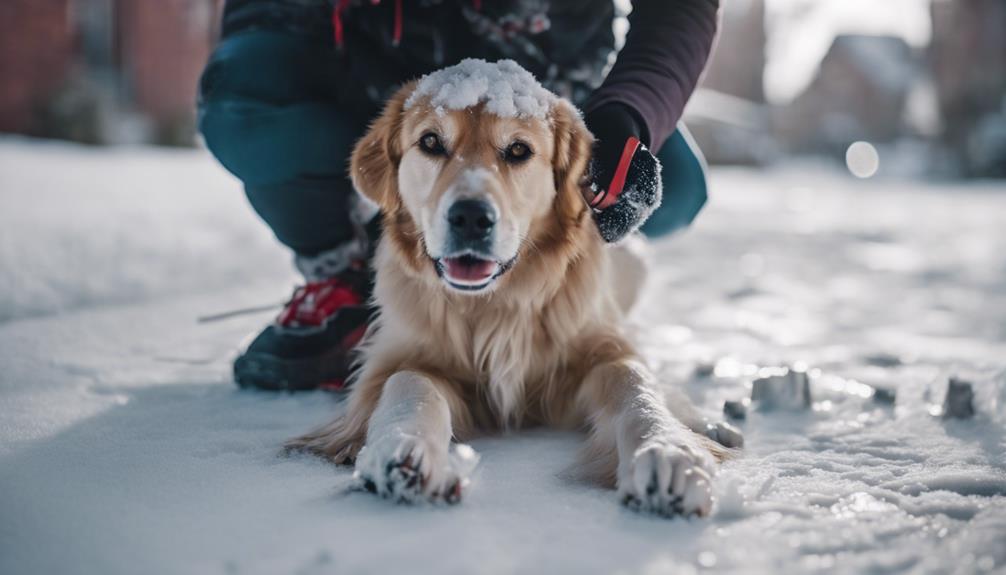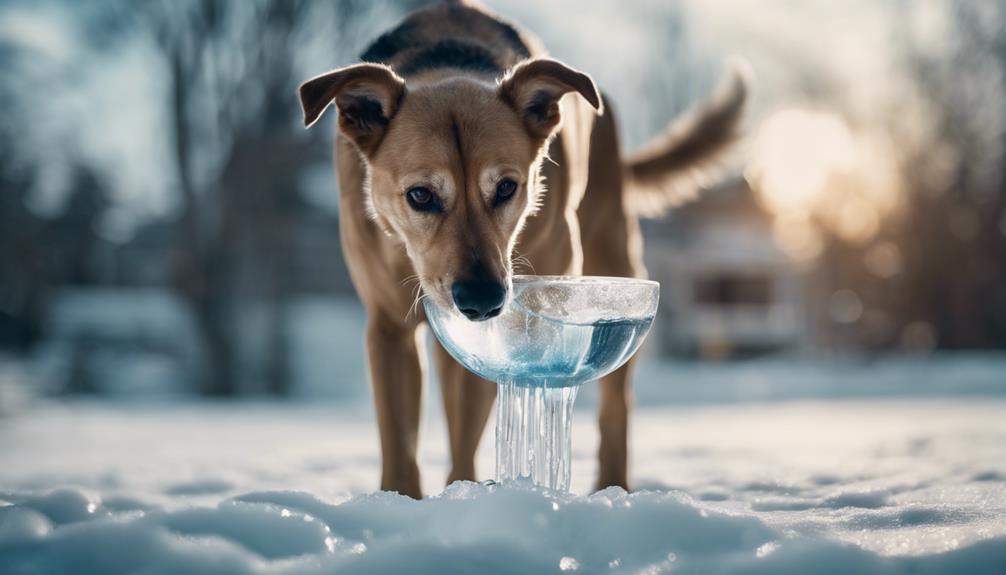As winter's icy grip tightens, the safety of our furry companions demands meticulous attention. From shielding delicate paws to recognizing the subtle signs of hypothermia, pet owners are faced with critical decisions to ensure their pets' well-being in extreme cold.
The following tips offer a comprehensive guide to navigating the challenges of winter weather and safeguarding our beloved animals. By implementing these strategies, pet owners can create a secure environment for their pets to thrive despite the harsh conditions.
Key Takeaways
- Protect pets' paws from cold and chemicals.
- Monitor for signs of hypothermia and dehydration.
- Provide indoor warmth and entertainment.
- Supervise pets near frozen water and ice.
Protecting Paws From Freezing Temperatures
When facing freezing temperatures, pet owners must take proactive measures to safeguard their furry companions' paws. Cold weather can be harsh on pets' delicate paw pads, leading to discomfort or injuries.
To protect their paws, consider using pet-safe ice melts on walkways, wiping their paws after outdoor walks to remove salt or chemicals, or investing in protective booties. Additionally, ensure pets come inside if they exhibit signs of discomfort like lifting their paws off the cold ground.
Providing Cozy Shelter for Outdoor Pets
To ensure the well-being of outdoor pets during the winter months, it is essential to provide them with a cozy shelter that offers protection from the cold weather. This shelter should be insulated, dry, and shielded from harsh winds to keep pets safe and warm.
Here are key points to consider when setting up a shelter for outdoor pets:
- Insulation: Use materials like straw or blankets to create a warm and insulated environment within the shelter.
- Dryness: Ensure the shelter remains dry to prevent dampness and maintain a comfortable living space for pets.
- Protection from Wind: Position the shelter in a location that minimizes exposure to cold winds, providing a cozy and secure retreat for outdoor pets.
Using Pet-Safe Ice Melts and Wiping Paws

Consider prioritizing the safety of your pets by utilizing pet-safe ice melts and implementing a paw-wiping routine during the winter months. Salt and ice melt chemicals can be harmful to pets, potentially causing irritation or toxicity.
Opt for pet-safe alternatives and wipe off your pet's paws or consider using protective booties to prevent exposure. This simple practice can help safeguard your pets' well-being and prevent issues like chemical poisoning from licking treated paws.
Additionally, regularly checking and cleaning your pet's paws after outdoor walks can reduce the risk of discomfort or injury from harsh winter conditions. By being proactive in these small ways, you can ensure your pets stay safe and healthy during extreme weather.
Monitoring for Signs of Hypothermia
In light of the risks posed by cold weather to pets, it is crucial for pet owners to be vigilant in monitoring their animals for signs of hypothermia. Hypothermia can be life-threatening to pets, especially during extreme winter conditions. Here are key points to consider when monitoring for signs of hypothermia:
- Watch for Shivering: Shivering is often the first sign of hypothermia in pets. If your pet is shaking or trembling uncontrollably, it may be a sign that their body temperature is dropping dangerously low.
- Check for Weakness: Weakness or lethargy can indicate that your pet is struggling to maintain their body heat. If your pet seems unusually tired or weak, it could be a sign of hypothermia.
- Monitor for Pale Gums: Pale gums can suggest poor circulation, which is a common symptom of hypothermia in pets. If you notice pale gums, it's essential to warm your pet up immediately and seek veterinary care if needed.
Supervising Pets Near Frozen Water

Monitoring pets near frozen water is essential to prevent accidents and ensure their safety during winter. As temperatures drop, bodies of water freeze over, posing risks to pets. It is crucial to keep pets leashed near frozen water bodies and securely cover swimming pools to prevent accidental falls.
Thin ice can be deceptive, leading to potential dangers if pets venture onto it. It is advisable to closely watch pets and discourage exploration on icy surfaces to avoid mishaps. By being vigilant and proactive in supervising pets around frozen water, pet owners can minimize the risks of accidents and keep their furry companions safe during extreme winter conditions.
Moisturizing Dry Winter Skin
As pet owners navigate the challenges of winter, ensuring proper care for their furry companions includes addressing the essential task of moisturizing dry winter skin. Dry skin can lead to discomfort and itching for pets, requiring proactive measures to maintain their skin health. Here are some tips to help moisturize your pet's skin during the winter months:
- Use a gentle, calming oatmeal shampoo for baths: This can help soothe dry and itchy skin.
- Apply coconut oil or vet-approved supplements: These can provide additional moisture and nourishment to the skin.
- Use a humidifier to increase air humidity: This can prevent dryness in the air, which can contribute to skin issues in pets.
Preventing Dehydration in Cold Weather

During the colder months, maintaining proper hydration levels for pets is crucial to their well-being and health. Even in cold weather, pets can easily become dehydrated. Carry water for walks and ensure pets drink enough to stay hydrated.
You can check for dehydration by gently grasping the skin; if it stays tented or takes time to return to its normal state, your pet may be dehydrated. Ensure water bowls don't freeze over, and monitor hydration levels regularly, even in cold weather.
Preventing dehydration in pets during winter is essential for their overall health and comfort. Stay vigilant and proactive in providing adequate water intake to keep your pets hydrated and healthy throughout the winter months.
Implementing Weather-Appropriate Grooming Practices
Proper grooming practices tailored to the weather conditions play a significant role in helping pets maintain optimal comfort and health during the winter months. It is essential to adjust grooming routines to suit the colder temperatures and protect pets from harsh winter elements. Consider the following tips for implementing weather-appropriate grooming practices:
- Regular Brushing: Brushing your pet regularly helps to remove excess fur and prevent matting, which can trap moisture and chill your pet.
- Trimming Paw Hair: Keep the hair between your pet's paw pads trimmed to prevent ice balls from forming and causing discomfort.
- Moisturizing Skin: Use pet-safe moisturizers to prevent dry, flaky skin caused by the cold, dry air.
Conclusion
In conclusion, safeguarding pets during extreme winter weather requires proactive measures such as:
- Protecting paws
- Providing cozy shelter
- Using pet-safe ice melts
- Monitoring for hypothermia
- Supervising near frozen water
- Moisturizing dry skin
- Preventing dehydration
- Implementing weather-appropriate grooming practices
By following these guidelines, pet owners can ensure the safety and well-being of their beloved companions in the face of challenging winter conditions.




